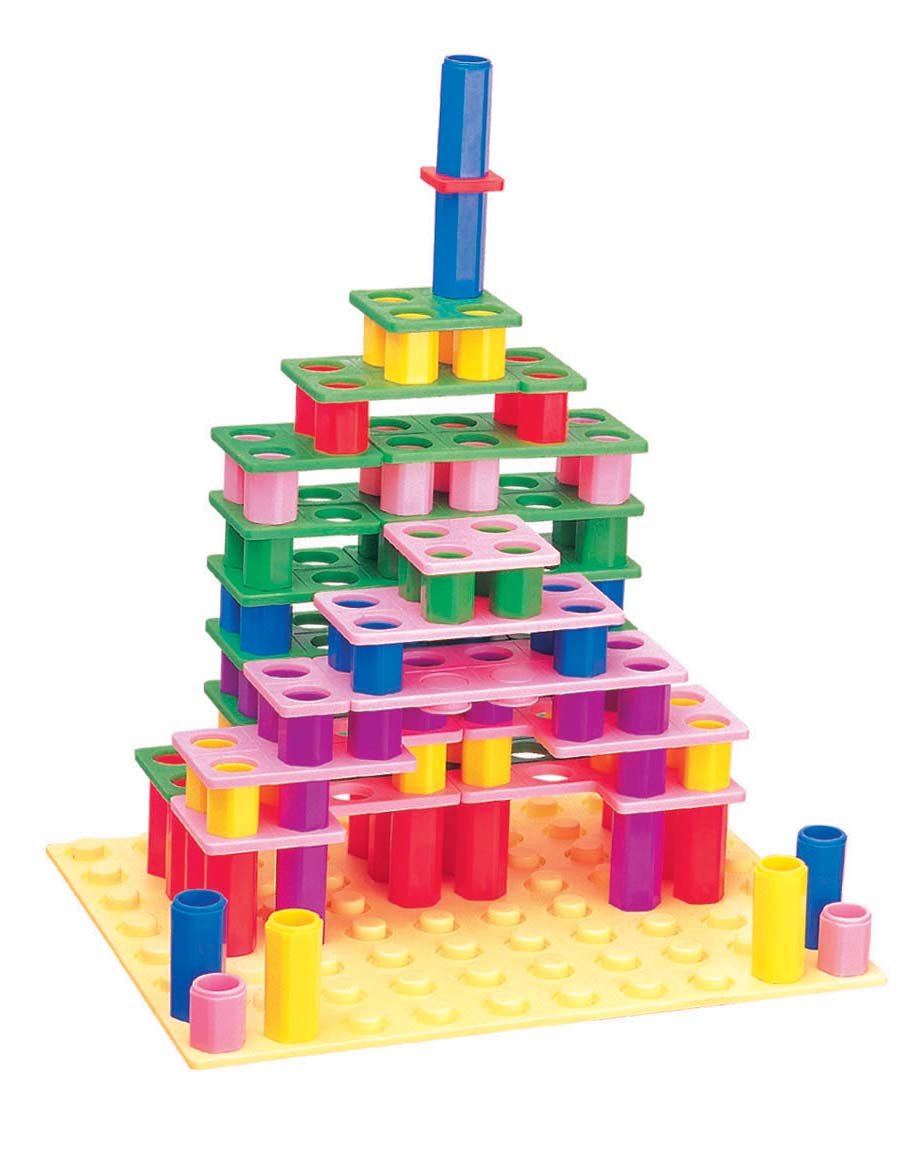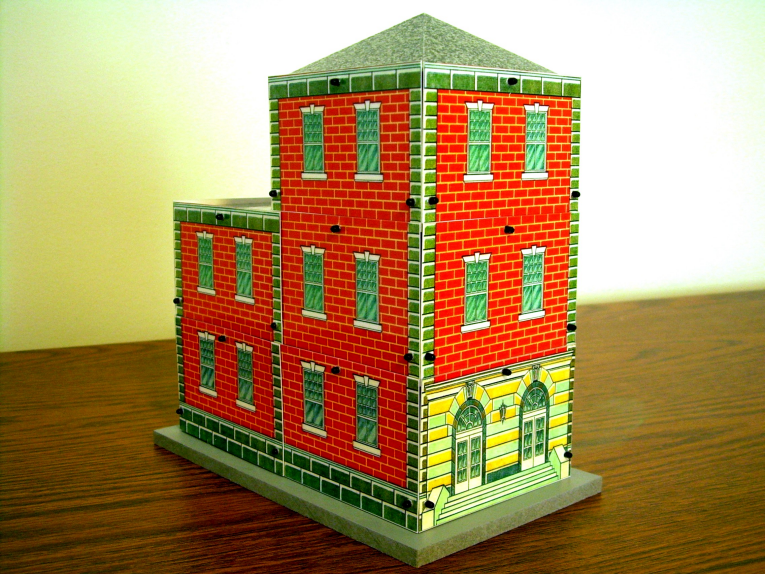Source:- Google.com.pk
Skyscraper Building Toy Biography
A skyscraper is a tall, continuously habitable building of many storeys, usually designed for office and commercial use. There is no official definition or height above which a building may be classified as a skyscraper. One common feature of skyscrapers is having a steel framework from which curtain walls are suspended, rather than load-bearing walls of conventional construction. Some early skyscrapers have a steel frame that enables the construction of load-bearing walls taller than of those made of reinforced concrete. Modern skyscrapers' walls are not load-bearing, and most skyscrapers are characterized by large surface areas of windows made possible by the concept of steel frame and curtain walls. However, skyscrapers can have curtain walls that mimic conventional walls and a small surface area of windows.
Skyscrapers since 1960s utilize the tubular designs, innovated by Bangladeshi-American structural engineer Fazlur Rahman Khan. This engineering principle makes the buildings structurally more efficient and stronger. It reduces the usage of material (economically much more efficient), while simultaneously allows the buildings to reach greater heights. It allows fewer interior columns, and so creates more usable floor space. It further enables buildings to take on various shapes. There are several variations of the tubular design; these structural systems are fundamental to tall building design today.[1][2][3][4] Other pioneers include Hal Iyengar, William LeMessurier, etc. Cities have experienced a huge surge in skyscraper construction.
Today, skyscrapers are an increasingly common sight where land is expensive, as in the centres of big cities, because they provide such a high ratio of rentable floor space per unit area of land. They are built not just for economy of space; like temples and palaces of the past, skyscrapers are considered symbols of a city's economic power. Not only do they define the skyline, they help to define the city's identity. In some cases, exceptionally tall skyscrapers have been built not out of necessity, but to help define the city's identity and presence or power as a city
A relatively small building may be considered a skyscraper if it protrudes well above its built environment and changes the overall skyline. The maximum height of structures has progressed historically with building methods and technologies and thus what is today considered a skyscraper is taller than before. Lately, the term 'supertall' has arisen for the current generation of tall buildings with a structural height of 300 m and more[5]. The CTBUH has now added the term 'megatall', for buildings with a height of 600 m and more.[6]
High-rise buildings are considered shorter than skyscrapers. The Home Insurance Building in Chicago, United States was considered a skyscraper when it was built in 1884, but it had only ten storeys. Today such a building would not be considered a skyscraper. There is no clear definition of any difference between a tower block and a skyscraper though a building lower than about thirty storeys is not likely to be a skyscraper and a building with fifty or more storeys is certainly a skyscraper.[7]
The term "skyscraper" was first applied to buildings of steel framed construction of at least 10 storeys in the late 19th century, a result of public amazement at the tall buildings being built in major cities like Chicago, New York City, Detroit, and St. Louis.[8] The first steel frame skyscraper was the Home Insurance Building (originally 10 storeys with a height of 42 m or 138 ft) in Chicago, Illinois in 1885. Some point to New York's seven-floor Equitable Life Assurance Building, built in 1870, as an early skyscraper for its innovative use of a kind of skeletal frame, but such designation depends largely on what factors are chosen. Even the scholars making the argument find it to be purely academic.[9]
The structural definition of the word skyscraper was refined later by architectural historians, based on engineering developments of the 1880s that had enabled construction of tall multi-storey buildings. This definition was based on the steel skeleton—as opposed to constructions of load-bearing masonry, which passed their practical limit in 1891 with Chicago's Monadnock Building.







BQ~~60_35.JPG)


Skyscraper Building Toy Biography
A skyscraper is a tall, continuously habitable building of many storeys, usually designed for office and commercial use. There is no official definition or height above which a building may be classified as a skyscraper. One common feature of skyscrapers is having a steel framework from which curtain walls are suspended, rather than load-bearing walls of conventional construction. Some early skyscrapers have a steel frame that enables the construction of load-bearing walls taller than of those made of reinforced concrete. Modern skyscrapers' walls are not load-bearing, and most skyscrapers are characterized by large surface areas of windows made possible by the concept of steel frame and curtain walls. However, skyscrapers can have curtain walls that mimic conventional walls and a small surface area of windows.
Skyscrapers since 1960s utilize the tubular designs, innovated by Bangladeshi-American structural engineer Fazlur Rahman Khan. This engineering principle makes the buildings structurally more efficient and stronger. It reduces the usage of material (economically much more efficient), while simultaneously allows the buildings to reach greater heights. It allows fewer interior columns, and so creates more usable floor space. It further enables buildings to take on various shapes. There are several variations of the tubular design; these structural systems are fundamental to tall building design today.[1][2][3][4] Other pioneers include Hal Iyengar, William LeMessurier, etc. Cities have experienced a huge surge in skyscraper construction.
Today, skyscrapers are an increasingly common sight where land is expensive, as in the centres of big cities, because they provide such a high ratio of rentable floor space per unit area of land. They are built not just for economy of space; like temples and palaces of the past, skyscrapers are considered symbols of a city's economic power. Not only do they define the skyline, they help to define the city's identity. In some cases, exceptionally tall skyscrapers have been built not out of necessity, but to help define the city's identity and presence or power as a city
A relatively small building may be considered a skyscraper if it protrudes well above its built environment and changes the overall skyline. The maximum height of structures has progressed historically with building methods and technologies and thus what is today considered a skyscraper is taller than before. Lately, the term 'supertall' has arisen for the current generation of tall buildings with a structural height of 300 m and more[5]. The CTBUH has now added the term 'megatall', for buildings with a height of 600 m and more.[6]
High-rise buildings are considered shorter than skyscrapers. The Home Insurance Building in Chicago, United States was considered a skyscraper when it was built in 1884, but it had only ten storeys. Today such a building would not be considered a skyscraper. There is no clear definition of any difference between a tower block and a skyscraper though a building lower than about thirty storeys is not likely to be a skyscraper and a building with fifty or more storeys is certainly a skyscraper.[7]
The term "skyscraper" was first applied to buildings of steel framed construction of at least 10 storeys in the late 19th century, a result of public amazement at the tall buildings being built in major cities like Chicago, New York City, Detroit, and St. Louis.[8] The first steel frame skyscraper was the Home Insurance Building (originally 10 storeys with a height of 42 m or 138 ft) in Chicago, Illinois in 1885. Some point to New York's seven-floor Equitable Life Assurance Building, built in 1870, as an early skyscraper for its innovative use of a kind of skeletal frame, but such designation depends largely on what factors are chosen. Even the scholars making the argument find it to be purely academic.[9]
The structural definition of the word skyscraper was refined later by architectural historians, based on engineering developments of the 1880s that had enabled construction of tall multi-storey buildings. This definition was based on the steel skeleton—as opposed to constructions of load-bearing masonry, which passed their practical limit in 1891 with Chicago's Monadnock Building.
Skyscraper Building Toy

Skyscraper Building Toy

Skyscraper Building Toy

Skyscraper Building Toy
Skyscraper Building Toy
Skyscraper Building Toy
Skyscraper Building Toy
Skyscraper Building Toy
Skyscraper Building Toy

Skyscraper Building Toy

Skyscraper Building Toy
https://www.quester.pk/question/does-ufone-have-3g-coverage-in-kharian/
ReplyDeletehttps://www.quester.pk/question/does-ufone-have-3g-coverage-in-khanpur/
https://www.quester.pk/question/does-ufone-have-3g-coverage-in-khanewal/
https://www.quester.pk/question/does-ufone-have-3g-coverage-in-kasur/
https://www.quester.pk/question/does-ufone-have-3g-coverage-in-kharachi/